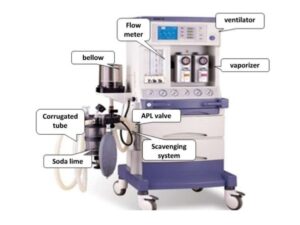Anesthesia Gas Monitoring
Description: Measures CO2 and volatile anesthetic agents (Halothane, isoflurane, Sevoflurane,
Enflurane, Desflurane. Mean alveolar concentration), RR & N20.
CO2 and volatile anesthetics absorb infrared light. By means of a pump, a small quantity of the breathing gas drawn through a measuring vessel, which is penetrated by infrared light. With the aid of various filters, frequency bands chose in which the only one of the gases to test absorbs light. The visual format of the sensor guarantees a quasi-continuous measurement of all gases. Absorption is a measurement of gas concentration in the vessel.
By simultaneous measurement of the temperature and absolute pressure in the vessel, the gas concentration of the breathing gas can be calculated.
Cross-sensitivity of gas measurement:
Vapors of organic substances in the ambient air, sample gas hose or T-piece,
(present in detergents or disinfectants), can distort the measurement of the concentration of volatile anesthetics.
installing the Water Trap :
Remove the new WaterLock® water trap from its packaging.
Note the date on the marked field of the water trap.
Grip the water trap by the ridged surfaces and push it into the holder until you feel it click into place.
Connecting the Sample Line :
Screw the filter into the T-Piece.
Plug the T-piece into the patient connection of the Y-piece with the filter on top
to prevent it from becoming clogged with liquid.
Screw the sample line firmly to the filter and water trap Leaks can distort the
measured values.
Instead of the T-piece and filter, the Y-piece can also be used with a direct connection for the sample line.
Recirculating sample gas :
To prevent increased anesthetic agent concentration in the operating theatre and conserve anesthetic agents.
To prevent undesired losses of tidal volume during low-flow applications.
Push the rubber sleeve on to the exhaust port on the back of the monitor, and plug the connector into the socket on the front of the breathing system.
Use recirculating SET and adapt it to the breathing system used.
Strictly follow the instructions for use of the breathing system.
If recirculation is not possible, the sample line should be routed to the anesthetic gas scavenging line.
Sample Gas Scavenging :
If recirculation is not possible
Hose Uses
Connect the hose to the spigot on the back of the device, push it into the anesthetic gas scavenging hose and secure it against slipping out.
The hose of the anesthetic gas scavenging line should have a diameter measuring at least twice that of the hose.
Calibration: Gas measurement calibrated automatically after every 2 hours by the machine.
During calibration, which lasts approximately 30 seconds, the message appears on the main screen.
Note
The recorder does not record AGM parameters.
If both 002 and AGM modules connected, 002 detected from the AGM module.
Following accessories are provided for AGM along with the monitor.
Airway Adapter (‘T’ connector)
Adult (2 nos.)
Paediatric (1 no.)
Water Trap (2 nos.)
Sample Line (8 ft.) (5 nos.)
Caution
Ensure to connect the exhaust nozzle to the scavenging system.
Perform daily checks and monitor calibration correctly.
Anesthesia GAS MONITORING
Sample lines, airway adapters, and water traps are disposable and single-use only.
In case of any water condensations in the sample line please replace the sample line with a new one.
Check the accessories before use.
Do not attempt to sterilize the accessories.
Use specified accessories only.